A well-crafted case study demonstrates real-world applications and showcases measurable success through detailed analysis. It highlights challenges faced, strategies employed, and tangible results to inspire and inform Your business decisions. Explore this article to uncover insightful case studies that drive meaningful growth.
Table of Comparison
| Aspect | Case Study | Autoethnography |
|---|---|---|
| Definition | In-depth analysis of a specific case or context | Self-reflective study connecting personal experience to culture |
| Purpose | Understand complex cultural phenomena within real-life settings | Explore cultural contexts through personal narrative and reflection |
| Data Source | Interviews, documents, observations from external subjects | Researcher's own experiences and reflections |
| Focus | External cultural or social settings | Internal, subjective cultural experience |
| Methodology | Structured data collection and analysis | Qualitative self-narrative and critical reflection |
| Outcome | Generalizable insights about culture or social phenomena | Deep, nuanced understanding of culture via personal lens |
Introduction to Case Study and Autoethnography
Case study research involves an in-depth, contextual analysis of a specific event, individual, group, or organization to explore complex phenomena within real-life settings, often utilizing multiple data sources for comprehensive insights. Autoethnography combines autobiographical storytelling with cultural analysis, emphasizing the researcher's personal experiences to understand broader social, cultural, and political meanings. Both methodologies prioritize rich, qualitative data but differ in focus: case study centers on external subjects while autoethnography foregrounds the researcher's subjective perspective.
Definitions and Key Concepts
Case study research involves an in-depth examination of a single unit such as an individual, group, or organization to explore complex issues within real-life contexts. Autoethnography combines autobiography and ethnography, where the researcher uses personal experience as a primary data source to analyze cultural phenomena and social interactions. Key concepts in case study include contextual analysis and bounded systems, while autoethnography emphasizes reflexivity and the significance of personal narrative in understanding broader cultural meanings.
Historical Development of Both Approaches
Case study research originated in the early 20th century within social sciences, emphasizing in-depth investigation of a single entity or phenomenon to understand complex issues in real-life contexts. Autoethnography emerged later, gaining prominence in the late 20th century as a qualitative research method combining autobiography and ethnography, focusing on personal experience as a way to understand cultural phenomena. Both approaches evolved with interdisciplinary influences, where case studies draw on psychology and sociology while autoethnography integrates narrative and reflexive practices from anthropology and literary studies.
Research Purpose and Scope
Case study research focuses on exploring and understanding a specific phenomenon within its real-life context, often aiming for in-depth analysis of processes, events, or conditions involving multiple data sources. Autoethnography centers on the researcher's personal experience to illuminate cultural, social, or organizational meanings, emphasizing reflexivity and subjective insight. The scope of case studies typically extends to broader organizational or societal contexts, while autoethnography narrows to individual narratives that connect personal experience with wider cultural understanding.
Data Collection Methods
Case study data collection methods primarily include interviews, observations, document analysis, and archival research to gather comprehensive, context-rich evidence about a specific phenomenon. Autoethnography relies heavily on self-reflective journaling, personal narratives, and introspective writing to analyze the researcher's own experiences within a cultural context. Both approaches emphasize qualitative data, but case studies aim for broader external data triangulation, while autoethnography centers on auto-biographical and subjective insights.
Analytical Techniques
Case study research employs analytical techniques such as pattern matching, explanation building, and cross-case synthesis to interpret complex phenomena within real-life contexts. Autoethnography utilizes narrative analysis and thematic coding to explore the researcher's personal experience and cultural insights, emphasizing reflexivity and subjectivity. The case study approach emphasizes external validity through triangulation of data sources, whereas autoethnography prioritizes internal validity by deeply analyzing personal meaning and cultural context.
Strengths and Limitations
Case study research offers detailed contextual analysis of a specific subject, enabling in-depth exploration of complex phenomena and generalization to similar contexts, but it often faces limitations in researcher bias and challenges in replicability. Autoethnography provides rich, personal insight by integrating the researcher's subjective experience with cultural analysis, fostering emotional connection and reflexivity, yet it may lack generalizability and can be criticized for excessive self-focus. Both methods emphasize qualitative depth, but case studies prioritize external context while autoethnography centers on internal lived experience, shaping their respective strengths and limitations.
Ethical Considerations
Case studies require strict adherence to participant confidentiality and informed consent to protect sensitive data, often managed through Institutional Review Boards (IRBs). Autoethnography involves self-reflection and personal narrative, raising unique ethical issues related to the representation of others and the researcher's vulnerability. Both methodologies demand transparency and reflexivity to navigate potential conflicts between authenticity and respect for participants' privacy.
Application Examples in Social Sciences
Case studies in social sciences often analyze a single individual, group, or event to explore complex phenomena, such as organizational behavior or educational reforms. Autoethnography emphasizes the researcher's personal experience to provide deeper cultural insights, commonly applied in studies of identity, trauma, and social justice. Both methodologies offer rich, contextualized data but serve different purposes: case studies for external observation and autoethnographies for introspective understanding.
Choosing Between Case Study and Autoethnography
Choosing between case study and autoethnography depends on research goals and focus: case studies analyze specific individuals, groups, or organizations to uncover contextual insights, while autoethnography emphasizes self-reflection and personal experience within cultural contexts. Case studies require objective data collection and external observation, contrasting with autoethnography's emphasis on subjective narrative and researcher's lived experience. Researchers prioritizing external validity and situational analysis often select case studies, whereas those exploring personal meaning and identity opt for autoethnographic methods.
Case Study Infographic

 libterm.com
libterm.com